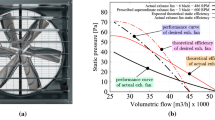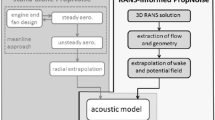Abstract
This paper describes a numerical optimization procedure for performance improvement of a tunnel ventilation jet fan. We employ optimization techniques based on a PRESS (predicted error sum of squares)-based-averaging (PBA) model to improve the aerodynamic performance of a tunnel ventilation jet fan. For numerical analyses, three-dimensional Reynolds-averaged Navier-Stokes (RANS) equations with a shear stress transport turbulence model are discretized using finite volume approximations and solved on hexahedral grids to evaluate the total efficiency at operating conditions as the objective function. Numerical results are verified by using experimental data for the total efficiency and the effective outlet velocity at operating conditions. Further, four geometric variables are used defining the meridional length and the thickness profile at the hub and shroud in the jet fan rotor as the design variables for numerical optimization. The results of numerical optimization show a significant improvement in the total efficiency of the optimum model in comparison with the base model.
Similar content being viewed by others
References
J. H. Ryu, W. H. Yoo and J. Kim, The Jet-fan Model Test for a Road Tunnel Ventilation, Journal of Air-Conditioning and Refrigeration, 15(8) (2003) 630–640.
R. N. Schlaug and T. J. Carlin, Aerodynamics and air quality management of highway tunnels, Prepared Report for Federal Highway Administration USA (1979) 2.49–2.56.
S. Levy, J. Sandzimier, N. Harvey, E. Rosenbluth, K. Karki and S. Patankar, CFD model for transverse ventilation systems, International Conference on Tunnel Fires and One Day Seminar on Escape from Tunnels, Lyons, France (1999) 223–233.
M. Tabarra, E. C. Bennet, R. D. Matthews, J. Armstrong and T. W. Smith, Eccentricity effects on jet fan performance in longitudinally ventilated rectangular tunnels, Paper presented at the I. Mech. E. Seminar Fans for Hazardous Applications, London (1994).
T. Nishioka, M. Jyohkoh and T. Kanno, Development of high-speed low-noise jet fan for modern tunnel ventilation system, The 9th Asian International Conference on Fluid Machinery, 9(56) (2007).
J. S. Byun, S. H. Kang, J. Kim and J. H. Lee, Ventilation analysis according to jet fan location in curved long road tunnel, Journal of SAREK, 19(9) (2007) 615–680.
J. O. Yoo, C. H. Nam and H. J. Shine, The study of jet fan control logic for longitudinal ventilation in road tunnel, Journal of SAREK, 12(8) (2000) 703–790.
S. H. Yang, Development of high speed compact jet fan, 2nd Annual report for MKE Strategic Technology Development Project (2010).
J. H. Kim, J. H. Choi, A. Husain and K. Y. Kim, Performance enhancement of axial fan blade through multi-objective optimization techniques, Journal of Mechanical Science and Technology, 24(10) (2010) 2059–2066.
Y. S. Choi, J. H. Kim, K. Y. Lee and S. H. Yang, Performance improvement of high speed jet fan, International Journal of Fluid Machinery and System, 3(1) (2010) 39–49.
S. H. Yang, Development of high speed compact jet fan, 1st Annual report for MKE Strategic Technology Development Project (2009).
ISO 13350, Industrial fans-performance testing of jet fans, INTERNATIONAL STANDARD (1999) 2–5.
JMP 6.0.0, The statistical discovery software, version 6.0.0, SAS Institute Inc., Cary, NC, USA (2005).
T. Goel, R. T. Haftka, W. Shyy and N. V. Queipo, Ensemble of surrogates, Structural and Multidisciplinary Optimization, 33(3) (2007) 199–216.
A. Samad, K. Y. Kim, Goel, T. R. T. Haftka and W. Shyy, Multiple surrogate modeling for axial compressor blade shape optimization, Journal of Propulsion and Power, 24(2) 302–310.
MATLAB®, The language of technical computing, Release 14, The Math Works Inc. (2004).
Author information
Authors and Affiliations
Corresponding author
Additional information
Recommended by Associate Editor Byeong Rog Shin
Joon-Hyung Kim received his B.S. and M.S. degrees from Hanyang University, Korea, in 2005 and 2007, respectively. He is pursuing his research towards the Ph.D in Fluid Mechanics at Hanyang University. And he is currently a researcher in the Korea Institute of Industrial Technology (KITECH). His research interests are computational fluid dynamics and design optimization of turbomachinery.
Jin-Hyuk Kim received his B.S. from Sunmoon University, Korea, in 2007, and his M.S, degree from Inha University, Korea, in 2009. Currently he is pursuing his research towards Ph.D degree in Thermodynamics and Fluid Mechanics at the Inha University. His research interests include design of turbomachinery, numerical analyses and optimization techniques.
Kwang-Yong Kim received the B.S. degree from Seoul National University in 1978, and the M.S. and Ph.D from the Korea Advanced Institute of Science and Technology (KAIST), Korea in 1981 and 1987, respectively. He is currently an Inha Fellow Professor in the School of Mechanical Engineering of the Inha University, Incheon, Korea. Professor Kim is also the current Editorin-Chief of the International Journal of Fluid Machinery and Systems (IJFMS). He is a Fellow of the American Society of Mechanical Engineers (ASME) and an Associate Fellow of the American Institute of Aeronautics and Astronautics (AIAA).
Joon-Yong Yoon received his B.S. and M.S. degrees from the Hanyang University and Ph.D from the Univ. of Iowa in Mechanical Engineering. He is a professor of Mechanical Engineering at Hanyang University. His research areas are in CFD for applications, renewable energy, MEMS and flow control.
Sang-Ho Yang received his B.S. and M.S. degrees from the Korea Polytechnic University, in 2006 and 2008, He is concurrently a Ph.D candidate at Korea Polytechnic University. And he is a director in the Samwon E&B. His research interests are in design and experiment of fans.
Young-Seok Choi received his B.S. degree from Seoul National University in 1988, and his M.S. and Ph.D in Mechanical Engineering at the same university in 1990 and 1996, respectively. He is currently a principal researcher in KITECH. His research interests are in computational fluid dynamics and design optimization of turbomachinery.
Rights and permissions
About this article
Cite this article
Kim, JH., Kim, JH., Kim, KY. et al. High-efficiency design of a tunnel ventilation jet fan through numerical optimization techniques. J Mech Sci Technol 26, 1793–1800 (2012). https://doi.org/10.1007/s12206-012-0420-9
Received:
Revised:
Accepted:
Published:
Issue Date:
DOI: https://doi.org/10.1007/s12206-012-0420-9




